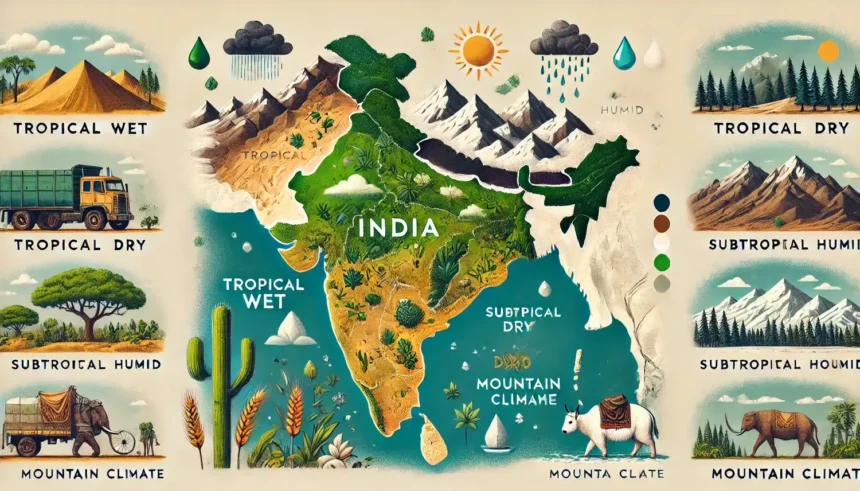The climate has a big impact on the geography, biodiversity, agriculture, and general social and economic structure of a country. The different climates across India’s huge land area have a big effect on nature.
In India, there are four main types of climates.
1.Tropical Wet
2. Tropical Dry
3.Subtropical Humid
4.Mountain Climate
The weather, temperature, and seasonal trends are used to form these groups. India has a wide range of climates, with each one having its own unique features and effects.
Tropical Wet Climate
The Tropical Wet Climate, also known as a monsoon climate, is predominantly found along the western coast, northeastern India, and the Andaman and Nicobar Islands. According to the Indian Meteorological Department (IMD), regions experiencing this climate receive annual rainfall exceeding 2000 mm, primarily during the southwest monsoon (June to September).
Affected Regions
Western Ghats-Stretching along the western coast, covering parts of Kerala, Karnataka, Goa, and Maharashtra.
Northeastern States-Including Assam, Meghalaya, Arunachal Pradesh, Nagaland, and parts of West Bengal.
Andaman and Nicobar Islands-Located in the Bay of Bengal, these islands are characterized by tropical rainforests and high humidity.
Temperature range
Annual Average-25°C to 30°C
Seasonal Variation-Minimal temperature variation throughout the year.
Flora and Fauna
Dense tropical rainforests, with trees like teak, rosewood, and bamboo.Western Ghats Home to species like the Indian elephant, Bengal tiger, Nilgiri langur, and Malabar giant squirrel.
Northeastern States Rich in biodiversity with animals such as the clouded leopard, one-horned rhinoceros, hoolock gibbon, and red panda.
Andaman and Nicobar Islands-Known for unique species like the saltwater crocodile, Andaman wild pig, and various endemic bird species.
Crops and Agriculture
The Tropical Wet Climate supports lush vegetation and agriculture that thrives on abundant rainfall:
Rice-A staple crop, particularly in Kerala, Assam, and West Bengal.
Tea-Grown extensively in Assam and the Nilgiri Hills in Tamil Nadu.
Spices- Kerala is known for its production of black pepper, cardamom, and cloves.
Rubber and Coconut-Particularly in Kerala and the Andaman Islands.
Lifestyle and Adaptation
The lifestyle in these regions is closely linked to the monsoon cycle. Traditional houses are designed with sloping roofs to manage heavy rains, and agriculture is often planned around the monsoon season. The rich biodiversity also supports various indigenous communities who rely on forest resources for their livelihood.
Tropical Dry Climate
The Tropical Dry Climate covers large parts of the Deccan Plateau, central India, and the western states like Rajasthan and Gujarat. The IMD classifies these regions as semi-arid to arid, with annual rainfall ranging between 500 mm and 1000 mm, mostly during a short monsoon season.
Affected Regions
Rajasthan-Particularly the Thar Desert, one of the driest regions in Indi
Gujarat-Including Kutch and Saurashtra regions.
Deccan Plateau-Covering parts of Maharashtra, Karnataka, Andhra Pradesh, and Telangana.
Madhya Pradesh and Chhattisgarh- Semi-arid regions in central India.
Temperature Range
Summer-25°C to 45°C, with peak temperatures sometimes exceeding 48°C in Rajasthan
Winter: 10°C to 25°C, with colder temperatures in the desert nights.
Flora and Fauna
Dominated by thorn forests, cacti, and scrub vegetation.
Thar Desert-Species such as the Indian gazelle (chinkara), desert fox, Indian bustard, and spiny-tailed lizard are commonly found.
Deccan Plateau– Includes animals like the Indian wolf, blackbuck, and various species of vultures and eagles.
Gujarat-The Gir Forest, located in this region, is famous for the Asiatic lion.
Crops and Agriculture
Agriculture in these regions relies heavily on irrigation and drought-resistant crops
Millets-Such as jowar (sorghum), bajra (pearl millet), and ragi (finger millet), which are staple crops in dry regions.
Pulses-Chickpeas, lentils, and pigeon peas are commonly grown.
Oilseeds- Groundnut and mustard are major crops, especially in Gujarat and Rajasthan.
Cotton-Particularly in Gujarat and Maharashtra, which have extensive cotton farming.
Lifestyle and Adaptation
The harsh conditions of the Tropical Dry Climate have led to the development of unique water conservation techniques, such as the construction of stepwells and tanks in Rajasthan. Traditional homes are often built with thick walls and small windows to minimize heat. In agriculture, practices like drip irrigation and rainwater harvesting are critical to sustaining crops.
Subtropical Humid Climate
The Subtropical Humid Climate is primarily found in the northern plains of India, including states like Uttar Pradesh, Bihar, Punjab, Haryana, and parts of West Bengal. According to the IMD, these regions experience moderate to high rainfall (1000 mm to 2000 mm) and marked seasonal variation, with hot summers and cool winters.
READ MORE –scientists-find-oceans-of-water-on-mars-its-just-too-deep-to-tap
Affected Regions
Indo-Gangetic Plains-Spanning from Punjab in the west to West Bengal in the east, covering states like Haryana, Uttar Pradesh, and Bihar.
Terai Region-The northern belt near the foothills of the Himalayas, including parts of Uttarakhand and northern Uttar Pradesh.
West Bengal- Particularly the eastern regions, which experience high humidity and rainfall.
Temperature Range
Summer- 25°C to 45°C, with peak temperatures in May and June.
Winter– 5°C to 20°C, with cooler temperatures in the northern parts of Punjab and Haryana.
Flora and Fauna
Vegetation: Includes fertile alluvial soil supporting diverse crops and natural vegetation like sal, teak, and mango trees.
Indo-Gangetic Plains– Rich in wildlife including animals like the Bengal tiger, Indian rhinoceros, swamp deer, and the Gangetic dolphin.
Terai Region– Home to species such as the Indian elephant, Indian leopard, and various deer species.
West Bengal: The Sundarbans region is famous for the Royal Bengal tiger and mangrove species like saltwater crocodiles.
Crops and Agriculture
Wheat and Rice– The Indo-Gangetic plains are known as the “Granary of India” due to extensive wheat and rice cultivation.
Sugarcane– Uttar Pradesh is the largest producer of sugarcane in India.
Fruits and Vegetables– Including potatoes, mangoes, and a variety of leafy greens.
Mustard– Especially in the cooler regions of Haryana and Punjab.
Lifestyle and Adaptation
This region has a rich agricultural heritage, with farming practices deeply rooted in the seasonal cycle. The abundant rainfall and fertile soil have made this area a hub of rural settlements. However, the region is also prone to flooding during the monsoon, leading to the need for extensive flood management systems, such as embankments and drainage channels.
Mountain Climate
The Mountain Climate is characteristic of the high-altitude regions of India, most notably the Himalayan range, extending across states like Jammu and Kashmir, Himachal Pradesh, Uttarakhand, Sikkim, and Arunachal Pradesh. The IMD notes that this climate varies significantly with altitude, with higher elevations experiencing colder conditions.
Affected Regions
Western Himalayas-Including Jammu and Kashmir, Himachal Pradesh, and Uttarakhand.
Eastern Himalayas-Spanning Sikkim, Arunachal Pradesh, and parts of West Bengal (Darjeeling).
Ladakh and Leh-High-altitude cold desert regions.
Temperature Range
Summer: 15°C to 25°C in lower altitudes, 0°C to 10°C in higher altitudes.
Winter: -20°C to 10°C, with extreme cold and heavy snowfall in the higher altitudes.
Flora and Fauna
Vegetation: Ranges from alpine forests to meadows and tundra, with trees like deodar, pine, and rhododendron.
Western Himalayas: Includes species like the snow leopard, Himalayan black bear, musk deer, and bharal (blue sheep).
Eastern Himalayas-Rich in biodiversity, with species like the red panda, Himalayan tahr, and various pheasants.
Ladakh and Leh: Home to the Tibetan antelope (chiru), wild yak, and the rare black-necked crane.
Crops and Agriculture
Apples and Orchards– Himachal Pradesh and Jammu and Kashmir are known for apple orchards.
Barley and Buckwheat-Grown in the higher altitudes where other crops may not thrive.
Tea-The Darjeeling region in West Bengal is famous for its high-quality tea.
Rice and Maize-Grown in the lower valleys where the climate is more temperate.
Lifestyle and Adaptation
The Mountain Climate presents unique challenges for human habitation. Terrace farming is a common practice to make use of limited arable land. Houses are built with thick walls and sloping roofs to withstand the cold and heavy snowfall.
The harsh winters often lead to seasonal migration, where people move to lower altitudes during the colder months. The region’s economy also heavily relies on tourism, with activities like trekking, skiing, and cultural tourism being major attractions.
Follow Climate India for more Environmental News. Connect with us on Facebook, Twitter, Instagram, and YouTube




